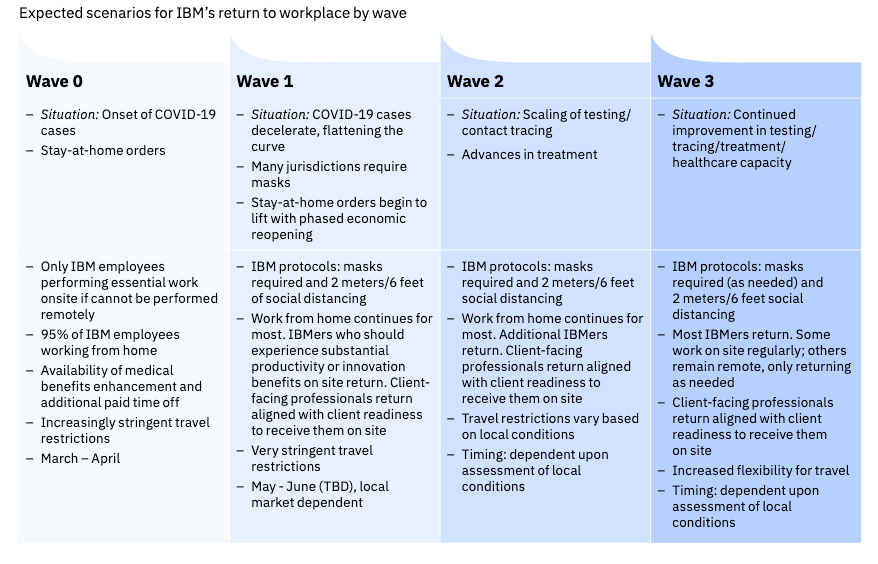The CHRO’s guide to workforce re-entry

Viewed through the lens of COVID-19, Michael Leavitt’s quote from 2007 now seems clairvoyant. The global pandemic has taken too many lives and decimated economies and livelihoods. It has also disrupted traditional thinking about where and how we work. Now, as we emerge from crisis response mode, organizations around the world are “reopening” to a new and very different normal—whether they have been completely shut down or only partially disrupted by COVID-19.
There is much we don’t yet know about how our work environments will look and feel when we move beyond this pandemic. One thing is certain: We will not be returning to business as usual. We will be working differently, whether we’re in an office building, a retail location, medical facility, factory, farmer’s market, or home office.
Many executives are now preparing the workplace and the workforce for safe operations during a “Wave 1” re-entry, while others are already midstream in that return to work. They all must monitor and protect the physical and mental health of their workers, implement appropriate testing measures, reconfigure facilities, provide protective equipment, and gain support from suppliers and others in the organization’s operational ecosystem.

CHROs have never been in a more essential position. They must augment their traditional focus on people with equal attention to the technology necessary to accelerate reentry and enable long-term success—the ability of the company, not just to survive, but to thrive in the different normal.
In this special report and corresponding checklists, we offer three simple steps for talent leaders to help their organizations emerge stronger by working safe and working smart.
- Look around as you plan for re-entry: Rethink roles, workflows, teams and new requirements to enable agility and flexibility for a different normal.
- Look inside to see how insights from data can help: Review how you collect and protect employee data and use it to monitor your reopening progress; create flexible new policies and practices as needed.
- Look ahead as you prepare for a new future: Reimagine how you can enable a resilient workforce that is prepared in terms of technical, professional and personal support and align workforce strategy and capabilities with business priorities.
 As the voice of the workforce, HR should first define what types of work and roles are needed in the office location—versus which can continue to be performed virtually. Prior to the pandemic, we may have had set ideas on which roles were “essential” to operate in an office. Now is the time to re-examine those perspectives and make recommendations that will enable agility and flexibility for the different normal we are returning to. Using data collected before or during the recent work-from-home period on productivity and engagement, decide who really needs to work in an office location and who doesn’t.
As the voice of the workforce, HR should first define what types of work and roles are needed in the office location—versus which can continue to be performed virtually. Prior to the pandemic, we may have had set ideas on which roles were “essential” to operate in an office. Now is the time to re-examine those perspectives and make recommendations that will enable agility and flexibility for the different normal we are returning to. Using data collected before or during the recent work-from-home period on productivity and engagement, decide who really needs to work in an office location and who doesn’t.
HR leaders now have a unique opportunity to accelerate the implementation of technology-enabled work process improvements as offices reopen. As Josh Bersin notes in his article, “The big reset: Making sense of the Coronavirus,” leaders now have the right—and the mandate—to fix things. He calls it “doing better with less.”
Leaders should use this period of exploration to look for opportunities to automate wherever possible, which can reduce the amount of work that needs to be done on-site and also keep human workers safer. As examples, Walmart is now deploying robots to scrub floors, and fast-food chain McDonald’s has begun testing robotic arms for cooking or serving, in order to maintain physical distancing.
They should also examine what data they’ll need to collect to meet the new requirements of a safe workplace, how they will collect it, and the implications this has for their HR policies and privacy concerns.
And now is the time to begin exploring how to tap artificial intelligence (AI) to keep the returning workforce informed, prepared and protected with personalized, meaningful updates.
Meet the authors
Amy Wright, Managing Partner, Talent and Transformation, IBM ConsultingCharlie Goldwasser, VP, Global Partner, Talent & Transformation
Download report translations
Originally published 13 May 2020


